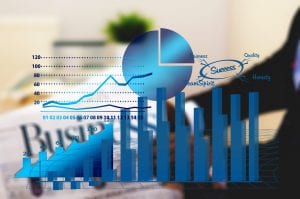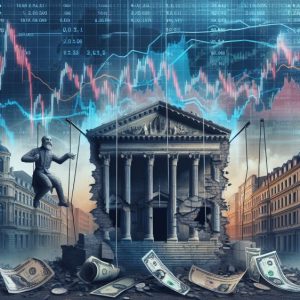
Understanding ‘Long and Variable Lags’: An Introduction
July 29. 2023
Today, we delve into the intriguing concept of ‘long and variable lags,’ a term coined by the renowned economist Milton Friedman. This exploration is particularly pertinent given the Federal Reserve’s recent aggressive rate hikes, the most assertive since 2001. The current economic landscape is characterized by elevated debt levels and a populace that is financially worse off than it was in 2001. A significant proportion of Americans today lack even a thousand dollars in savings to cover an unforeseen expense.
The Concept of ‘Long and Variable Lags’
The concept of ‘long and variable lags’ was introduced by Friedman to elucidate the time it takes for economic policies to fully permeate and influence the economy. To simplify, ‘lags’ refer to the time delays between the implementation of an economic policy, such as changes in taxes, interest rates, or government spending, and the realization of the full effects of that policy on the economy.
Short Lags vs Long Lags
Some economic policies have short lags, meaning their impact on the economy is felt relatively quickly. For instance, if the government augments spending on infrastructure projects, the immediate beneficiaries, such as those in construction jobs, will start earning more and spending that money, thereby stimulating economic activity almost instantaneously.
Conversely, some policies have long lags, implying a considerable time lapse before their full effects are felt. For instance, if the government decides to invest more in education to enhance the skill level of the workforce, it may take years or even decades for the benefits of a more skilled workforce to manifest in the form of increased productivity and economic growth.
Variable Lags and Their Implications
The length of the lags can vary depending on the specific economic policy and the circumstances of the economy. Some policies might have longer lags in one situation but shorter lags in another. Understanding these long and variable lags is crucial for policymakers. If they fail to consider these lags, they might implement policies that have unintended consequences. For example, suppose they attempt to stimulate the economy during a downturn with a short-term policy. In that case, it might not have the desired effect until the economy has already recovered, leading to unnecessary inflation or other problems.
The Relevance of ‘Long and Variable Lags’ in the Current Economic Climate
The relevance of the concept of ‘long and variable lags’ becomes apparent when examining the current rate-hiking environment. It signifies that changes in interest rates may not immediately impact the macro economy, and the duration of this lag can vary, being unpredictable in nature.
It is reasonable to expect that the impact of the 11 rate hikes implemented by the Fed since March 2022 will eventually permeate the economy. The crucial question is when this impact will manifest. Typically, the effects of a rate-hiking cycle become evident within 6 to 24 months after the cycle concludes, drawing parallels to the situation in 2006.
Two years after the equity and debt markets hit long-term lows, the Fed started increasing the fed funds rate in the summer of 2004. They raised it 17 times over the next two years, each by 25 basis points, ultimately reaching a rate of 5.25%.
The subsequent bear market, which was part of the Global Financial Crisis, didn’t materialize immediately. Even one year after the final fed funds hike in June 2006, debt and equity market indices still surged. However, the first signs of trouble began to emerge in the latter half of 2007.
The Impending Economic Distress: A Perspective
Top economist David Rosenberg, in an exclusive interview with MarketWatch, argues that the US stock market has turned into a “get-rich-quick” scheme, concealing the forthcoming economic distress. He remains bearish on the economy, dismissing the possibility of a soft landing, and criticizes the Federal Reserve’s tightening policies.
Rosenberg points out that the Fed has raised interest rates by 500 basis points over the past five quarters to combat high inflation. While this has slowed down consumer-price increases, he believes there is still no chance of a smooth economic slowdown, given the aggressive tightening measures.
The Disconnect Between the Stock Market and the Economy
Despite the buoyancy of the equity market, with the S&P 500 rallying 19% in 2023, Rosenberg argues that this growth does not reflect the actual state of the economy. He sees the stock market’s surge as driven by speculative frenzy and “get-rich-quick” behaviour rather than an indication of economic strength.
For months, Rosenberg has warned about an impending US recession and raised concerns about a potential plunge in the S&P 500 and American consumers depleting their savings.
Conclusion: A Day of Reckoning May Be Closer Than We Think
In conclusion, the concept of ‘long and variable lags’ is a critical tool for understanding the dynamics of economic policy implementation and its subsequent effects. It underscores the importance of strategic timing and careful consideration of the broader economic context. As we navigate the current financial landscape, marked by aggressive rate hikes and high debt levels, it is crucial to remember the lessons of the past and heed the warnings of experts like Rosenberg. The stock market’s recent growth may be more of a speculative frenzy than a reflection of economic strength, and a day of reckoning may be closer than we think.
Articles That Cover a Spectrum of Timeless Topics

Which of the Following Investing Statements Is False? Let’s Uncover the Truth!

An Exquisite Approach: How to Buy Gold Without Paying Sales Tax

Extra return generated through market timing strategies is not for risk

How to Buy Gold in Australia: A Captivating Roadmap to Glittering Riches

The Art of Portfolio Agility: Mastering the Tactical Asset Allocation Strategy

Stock Market Forecast for Tomorrow: Ignore Noise, Focus on the Trend

Defying the Crowd: Exploring the Stock Market Fear Index

Crowd Behavior Psychology: Deciphering, Mastery, and Success

Inflation vs Deflation vs Stagflation: Strategies for Triumph

What Is The Best Way For One To Recover After a Financial Disaster?

The Psychology of Investing: Shifting Focus from the Crowd to the Trend

What Development In The Late 1890s May Well Have Prevented Another Financial Disaster?

Mass Psychology of Stocks: Ride the Wave to Win

How Inflation Erodes Debt and Strategies for Smart Investing

Demystifying StochRSI Strategy: Easy Strategies for Winning


